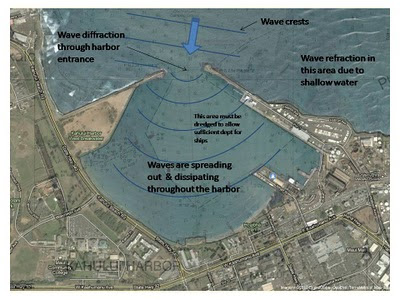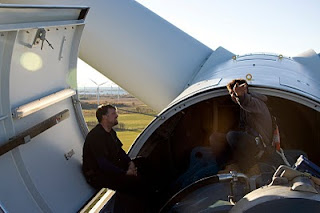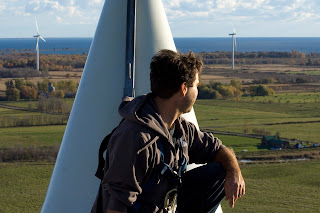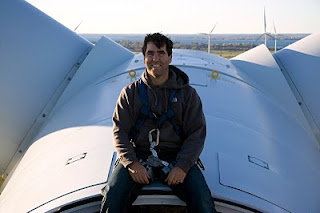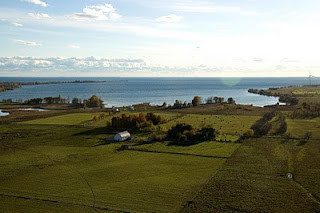Wow, another banger day at Sandbanks. I took the day off work to score what might be one of the last warm(ish) days of the year. Forecast was for roughly 25-30kts WSW, 11°C and drizzly rain. Well, we got probably 30-35kts, no rain, and even a 3hr patch of sunshine. A whole whack of us launched out of a rented cottage on West Pt, which just really makes the whole Mac's experience comfortable and easy. There was a big contingent from Montreal and Quebec City, including the Makani Fin guys and a crazy guy named Mathieu with balls of steel. Also joining us was John, Reiner and Chris from T-dot and Nic from Ottawa, equipped with nothing but a camera and generosity out the ass to film and shoot us all day long.

The morning arrival revealed somewhat dubious conditions. I was there early - too early, while all the other bums were sleeping in and enjoying a nice breakfast at Isaiah Tubbs. I was on the verge of launching from West Pt proper when my buddy Ilan called and said he had secured rental of a cottage lawn off MacDonald's Lane - not the cottage itself, just the lawn. Eventhough the launch at West Pt would have put me right up in ye old G-Spot, it would have been damn lonely, so I packed back up and went to the cottage to hook up with some great guys who are rapidly become great friends. Some of the regular crew that I seem to be logging some decent SBX time were there; Ilan, Amine, JFLemay, Uncle Tom, Guy Trudeau and a number of others that I met for the first time.
The worst was, we all showed up, and the conditions looked lame as.
Thankfully, it didn't take more than about 15 minutes for the conditions to kick in. The winds were reported to be WSW, which puts it a few degrees offshore there, so the inside was a bit on the light side, and the waves were small. I rigged my 4.2 and ventured way upwind to 'Upper Macs', the 'G-Spot', or whatever you want to call it. JF soon followed but Amine had rigged a 4.5 and was too overpowered on the outside to come up. Everyone else was still rigging, or bitching about their gout ;) I'd say, in the beginning, it was much better up there. I stayed at Upper Macs for about an hour riding some head- to logo-high waves, waves that were wrapping just enough so the smacks were working well without needing to get too backwinded. I had some sweet rides, and some waves just kept going and going down into the shallow bay. Not always, but most of the time, waves were clean clean clean with easily 5 turns or more. Blissful. A very cool experience to be only two of us up there just picking off the best of 'em.
Probably even more fun than the 'riding up there' part, was the proceding 'downwind part'. Just the way the waves work there, you can keep riding and riding, then jibe onto the next one without the up-wind battle. By then the wind was smoking - nicely overpowered on the outside, and usually just-about-right on the inside - the way I like it. I think it took me about 3 waves to get back down to the cottage, which was about 400-500m downwind. More sailors had emerged, Nic was filming and guys like Guy and Amine were pulling out all their material for the lens.
Around that time, the sun started to poke out and you could see everyone's energy level starting to ramp up a notch or two. Lots of action out there. I saw JF trying some pushies, Guy working the backs with some freestyle stuff like air taka attempts on the inside, and lots of guys just working those waves hard and pushing their personal boundaries. What a day! Probably one of the highlights as I mentioned was Mathieu from Quebec City. His riding was refined for sure but what stood out to me was his ballsy jumping. There are not many folks who go for brokes when they loop, but he sure was. I saw some nice beefy stalled forwards, numerous pushies and backloops (landed?, not sure). Anyway, it appeared that in the air, he was for sure a substantial notch above the rest of us folk in terms of comfort, how high he was going and what he was landing.
I also had one particular wave, nothing special, but the guy upwind of me (Le Jeune?), had picked up a set wave. I kept trying to look back, since it was worth watching. I think he rode that thing with all he had... I recall at one point, glancing back to what looked like about mast-high, and there he is cruising down the face frontside with the wave peeling around him. Awesome! I heard later he was pulling some nice lay-down bottom turns 'a la Polakow'.
The vibe was great, the wind and waves were excellent, and we were all together, sailing the same spot, pushing each other and making the most of what could always end up being the last session of the year. Smiles everywhere! I think that is what I really like about this gang - no bitching and complaining (albeit there was nothing to bitch about), just smiles, banter and stoked people all around me. I miss that - that just isn't Kingston anymore. Our once thriving and boisterous scene is largely disbanded... :(
A bunch of us got together for fish'n'chips on the way out of town to wrap up the day with bullshit tales of our double mast high waves, one-handed cut-backs and goiters. Great gang, and an awesome day. Maybe someday I'll have to get off my butt and re-learn french! Gotta throw in a thanks to the guys for tolerating my lack of francais...
A huge props to Nic for coming down all the way from Ottawa to catch the action! As it becomes available, I will start adding some of his footage to this blog post.
Some photos in the
Windsurfing Quebec Website.
SBX Wipeout Overture from Nicolas Chapleau on Vimeo.
SBX Oct 28th Fun in the Waves from Nicolas Chapleau on Vimeo.
Also some
photos by Fathom (John Vu, including the tree photo at the top).
Sandbanks really is an amazing place. I imagine anyone who sails there during a day like this realizes how lucky we are to have this priceless spot, a spot that is simply shaped right and set-up to go off a handful of times per year, and produce some of the best wave-riding dare I say in the entire country. For those who experience the front-side down-the-line riding it has to offer, there is nothing better. I imagine it's akin to a skier scoring their first two feet of fresh powder, or stomping their first big cliff jump. You just know it is something you have to do again, and the sooner the better. To explain it to the non-windsurfer - it's our version of crack. It's just SO damn good.
Hey there! If you like what you read, please support my interest in blogging by posting a comment or clicking links!








